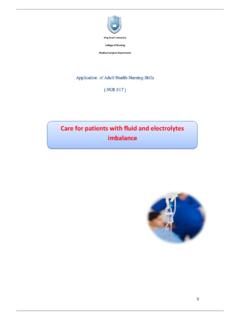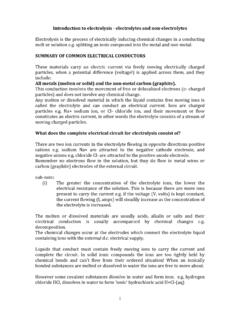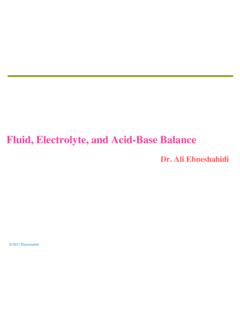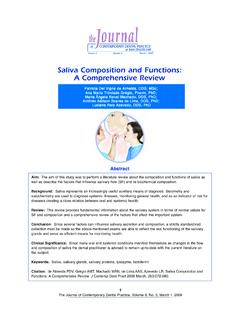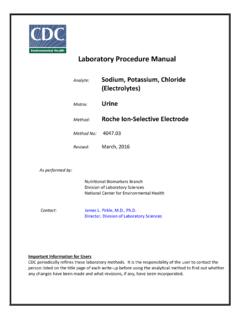Transcription of SOLID ELECTROLYTES FOR NEXT GENERATION BATTERIES
1 SOLID ELECTROLYTES FOR next GENERATION . BATTERIES . PI: John B. Goodenough Presented by: Long Wang Texas Materials Institute The University of Texas at Austin Project ID: ES15. DOE Vehicle Technologies Annual Merit Review Meeting May 14-18, 2012. This presentation does not contain any proprietary or confidential information. 1 The University of Texas at Austin Overview Timeline Barriers Project Start Date-Sept. 2010 Stable SOLID electrolyte with Project End Date- Aug. 2013 Li > 10-4 S/cm Percent complete: 50% complete Thin SOLID electrolyte membrane with enough mechanical strength Budget Partners Funding received in FY10-FY11.
2 $70K Oak Ridge National Laboratory Funding received in FY11-FY12. $70K. 2 The University of Texas at Austin Milestones Test liquid-cathode Li battery in which the pH of the cathode solution is alkaline. (Completed). Test a composite Li+-ion SOLID electrolyte . ( Partially completed). Test stability of garnet electrolyte in water. (Partially completed). Identification of a new Li+-ion SOLID electrolyte and/or compounds for a Na+-ion battery. (Ongoing). 3 The University of Texas at Austin Motivations A typical State-of-art lithium-ion battery e- e- - Separator +. Li+. Anode Li+. Cathode (Reducing Agent) (Oxidizing Agent).
3 Li+. SEI layer electrolyte Capacity limited by Li SOLID solution in cathode and loss in SEI layer Voltage limited by Eg of carbonate electrolyte . 4 The University of Texas at Austin Why SOLID electrolyte separator? Enabling use of lithium metal anode to increase cell voltage and capacity Eliminating irreversible Li loss from cathode side during the first charge Enabling use of liquid cathodes with higher capacity than insertion hosts 5 The University of Texas at Austin Objectives Objective: Increase the cell voltage and capacity by using lithium metal anode and a SOLID electrolyte separator allows varied cathode strategies.
4 Specific objectives: Identify a SOLID electrolyte with Li +>10-4 S cm-1 at room temperature that is stable against lithium Fabricate a thin, robust and chemically stable electrolyte membrane Build a high-voltage cell with a liquid catholyte, a SOLID electrolyte membrane as separator and lithium metal as anode. 6 The University of Texas at Austin Existing SOLID ELECTROLYTES Contamination by aluminum at high temperature makes it unstable in aqueous solution Garnet structure ELECTROLYTES are electrochemically stable with a larger window than commercial LISICON membrane and are not sensitive to water as sulfides, so they are a promising separators for flow-through BATTERIES using aqueous solutions.
5 7 The University of Texas at Austin Approach Garnet: A3B3C2O12. Garnet framework: B3C2O12. Interstitial spaces for lithium 24d La Ta Li O. La3Ta2O12 framework with Li in interstitial Tetrahedral sites 24d bridged by space octahedra with positions 96h and 48g. 8 Structure of The University of Texas at Austin Technical accomplishment Refined structure parameters of cubic Li7La3Zr2O12. Atom Site Occupation X Y Z Uiso/Ueq ( 2 ). Li1 24d (12) 3/8 0 (2). Li2 96h (3) (8) (8) (9) (3). La 24c 1 1/8 0 Zr 16a 1 0 0 0 O 96h 1 (10) (11) (13) Al-free sample has been prepared via a low-temperature synthesis route. Neutron diffraction results reveal that lithium barely occupies 48g site in Li7La3Zr2O12.
6 9 The University of Texas at Austin 3D connection of Li sites within the interstitial space of Li site occupancies vs Li content per formula unit the garnet framework with Li per formula unit. from neutron diffraction. Short-range order of lithium appears when the Li content per formula unit approximates 7. It is noticed there is a transition point near per formula unit, so we suspected the maximum lithium conductivity is in this region. 10 The University of Texas at Austin Lithium pathway in Li7La3Zr2O12. Two-dimensional contour maps sliced on the (001). plane with z = at (a) RT, (b). 200, (c) 400 and (d) 800 C, respectively; Li delocalizes along the 3-dimensional chain, Li(24d)-Li(96h)-Li(48g)-Li96h)- Li(24d) direction, whereas Zr, La and O remain near their original positions.
7 *Accomplished by collaboration with Los Alamos National Laboratory 11 The University of Texas at Austin Optimization of Lithium content (S/cm). x of Li7-xLa3Zr2-xTaxO12. In accordance with prior result results, a maximum Li+ > 10-3 S cm-1. has been obtained at x= (nominal composition ). 12 The University of Texas at Austin Table 1 Comparison of the lattice parameter and Table 2 Room-temperature ionic density for Li6La3 SnMO12. conductivity and activation energy for Li6La3 SnMO12 at 20 oC. Lattice Ionic Theoretical Real Relative Li Nominal Nominal Composition Ea (eV). parameter radius of density (g density density (S cm-1).)
8 Composition ( ) M5+ ( ) cm-3) (g cm-3) (%). Li6La3 SnSbO12 10-4 Li6La3 SnSbO1. 2. Li6La3 SnNbO12 10-4 Li6La3 SnNbO1. Li6La3 SnTaO12 10-4 2. Li6La3 SnTaO1. Li6La3 ZrTaO12[3] 10-4 2. Li6La3 ZrNbO12[4] ~ 10-4 ~ Comparison of the Li+ conductivities of the garnets show a clear trend to higher Li+ conductivity the stronger the covalent bonding within the garnet framework; this effect is more important than the size of the interstitial volume within which the Li+. ions move. Stronger covalent bonding within the framework reduces the strength of the oriented Li bonding in the interstitial space. 13 The University of Texas at Austin Make the SOLID - electrolyte membrane thin and strong Deposit a thin layer on a porous substrate that allows carbonate electrolyte to pass through.
9 Make polymer/ SOLID - electrolyte composites that are stable and flexible. Dense thin layer of garnet porous substrate electrolyte deposited via ( Al2O3 ,YSZ ). PLD. Lithium dendrites Organic electrolyte (EC, DEC, DMC, PC ) in pores 14 PLD and spin-coating are accomplished by ORNL The University of Texas at Austin A lithium-bromine battery using a garnet SOLID electrolyte separator Garnet SOLID electrolyte is stable in bromine carbonate solution Bromine can be a very promising liquid catholyte for flow-through battery owing to its high open circuit voltage (4V) and high capacity (335 mAh/g). that is much higher than insertion compounds.
10 15 The University of Texas at Austin Garnet/Polymer composite SOLID electrolyte 1. Garnet/PEO composite electrolyte for SOLID State Battery 1500. + LiTFSI salt x 10-4 S cm-1 at 1000. Z". PEO tail 500. 0. 1000 1500 2000 2500. Z'. Polymer glue layer pH ~ 7 in water Garnet SOLID electrolyte , with polymer protective layer New Finding 2. Water-stable Garnet SOLID electrolyte Long-term stability at high pH/temp. condition Compatibility of the structure with organic electrolyte Lithium-ion permeability 16 The University of Texas at Austin Summary A low-temperature synthesis route has been developed to prepare aluminum-free Li7La3Zr2O12 garnet electrolyte and the lithium distribution in cubic La3Zr2O12 garnet framework has been resolved.










